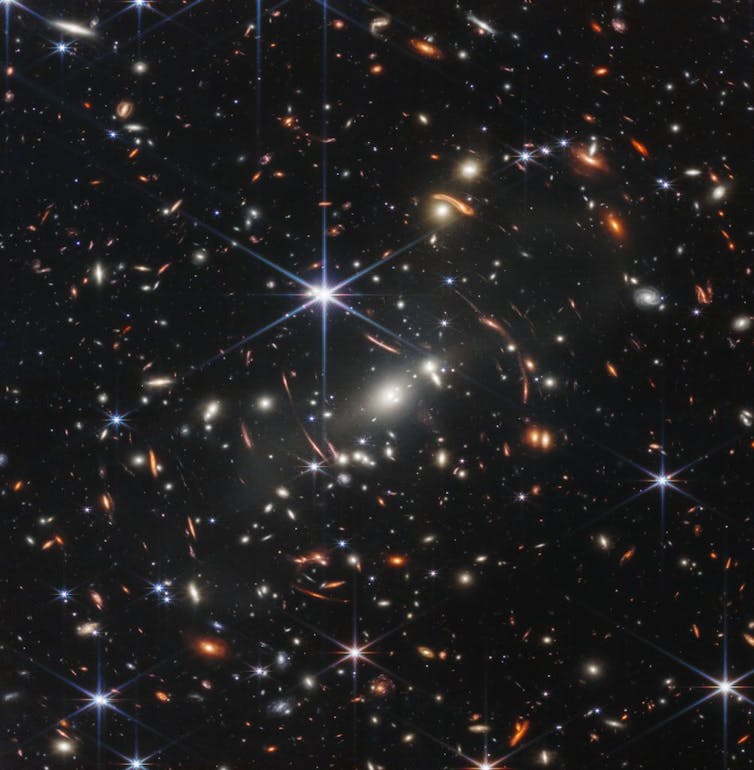Why is space so dark despite all of the stars in the universe? – Nikhil, age 15, New Delhi
People have been asking why space is dark despite being filled with stars for so long that this question has a special name – Olbers’ paradox.
Astronomers estimate that there are about 200 billion trillion stars in the observable universe. And many of those stars are as bright or even brighter than our sun. So, why isn’t space filled with dazzling light?
I am an astronomer who studies stars and planets – including those outside our solar system – and their motion in space. The study of distant stars and planets helps astronomers like me understand why space is so dark.
You might guess it’s because a lot of the stars in the universe are very far away from Earth. Of course, it is true that the farther away a star is, the less bright it looks – a star 10 times farther away looks 100 times dimmer. But it turns out this isn’t the whole answer.
Imagine a bubble
Pretend, for a moment, that the universe is so old that the light from even the farthest stars has had time to reach Earth. In this imaginary scenario, all of the stars in the universe are not moving at all.
Picture a large bubble with Earth at the center. If the bubble were about 10 light years across, it would contain about a dozen stars. Of course, at several light years away, many of those stars would look pretty dim from Earth.
If you keep enlarging the bubble to 1,000 light years across, then to 1 million light years, and then 1 billion light years, the farthest stars in the bubble will look even more faint. But there would also be more and more stars inside the bigger and bigger bubble, all of them contributing light. Even though the farthest stars look dimmer and dimmer, there would be a lot more of them, and the whole night sky should look very bright.
It seems I’m back where I started, but I’m actually a little closer to the answer.
Age matters
In the imaginary bubble illustration, I asked you to imagine that the stars are not moving and that the universe is very old. But the universe is only about 13 billion years old.
Galaxies as they appeared approximately 13.1 billion years ago, taken by the James Webb Space Telescope. NASA/ESA/CSA/STScI/Handout from Xinhua News Agency via Getty Images
Even though that’s an amazingly long time in human terms, it’s short in astronomical terms. It’s short enough that the light from stars more distant than about 13 billion light years hasn’t actually reached Earth yet. And so the actual bubble around Earth that contains all the stars we can see only extends out to about 13 billion light years from Earth.
There just are not enough stars in the bubble to fill every line of sight. Of course, if you look in some directions in the sky, you can see stars. If you look at other bits of the sky, you can’t see any stars. And that’s because, in those dark spots, the stars that could block your line of sight are so far away their light hasn’t reached Earth yet. As time passes, light from these more and more distant stars will have time to reach us.
The Doppler shift
You might ask whether the night sky will eventually light up completely. But that brings me back to the other thing I told you to imagine: that all of the stars are not moving. The universe is actually expanding, with the most distant galaxies moving away from Earth at nearly the speed of light.
Because the galaxies are moving away so fast, the light from their stars is pushed into colors the human eye can’t see. This effect is called the Doppler shift. So, even if it had enough time to reach you, you still couldn’t see the light from the most distant stars with your eyes. And the night sky would not be completely lit up.
The Doppler shift, also known as the redshift, is a phenomenon in which light from objects that are moving away from an observer appears more toward the red end of the spectrum.
If you wait even longer, eventually the stars will all burn out – stars like the sun last only about 10 billion years. Astronomers hypothesize that in the distant future – a thousand trillion years from now – the universe will go dark, inhabited by only stellar remnants like white dwarfs and black holes.
Even though our night sky isn’t completely filled with stars, we live in a very special time in the universe’s life, when we’re lucky enough to enjoy a rich and complex night sky, filled with light and dark.



 Cogent Biosciences Soars 120% on Breakthrough Phase 3 Results for Bezuclastinib in GIST Treatment
Cogent Biosciences Soars 120% on Breakthrough Phase 3 Results for Bezuclastinib in GIST Treatment  Is space worth the cost? Accounting experts say its value can’t be found in spreadsheets
Is space worth the cost? Accounting experts say its value can’t be found in spreadsheets  Neuren Pharmaceuticals Surges on U.S. Patent Win for Rare Disorder Drug
Neuren Pharmaceuticals Surges on U.S. Patent Win for Rare Disorder Drug  FDA Pilot Program Eases Rules for Nicotine Pouch Makers
FDA Pilot Program Eases Rules for Nicotine Pouch Makers  SpaceX Starship Explodes in Texas During Test, Citing Nitrogen Tank Failure
SpaceX Starship Explodes in Texas During Test, Citing Nitrogen Tank Failure  Trump and Merck KGaA Partner to Slash IVF Drug Costs and Expand Fertility Coverage
Trump and Merck KGaA Partner to Slash IVF Drug Costs and Expand Fertility Coverage  NASA Resumes Cygnus XL Cargo Docking with Space Station After Software Fix
NASA Resumes Cygnus XL Cargo Docking with Space Station After Software Fix  SpaceX’s Starship Completes 11th Test Flight, Paving Way for Moon and Mars Missions
SpaceX’s Starship Completes 11th Test Flight, Paving Way for Moon and Mars Missions  Tabletop particle accelerator could transform medicine and materials science
Tabletop particle accelerator could transform medicine and materials science  Trump Administration to Launch Autism Initiatives Targeting Acetaminophen Use and New Treatment Options
Trump Administration to Launch Autism Initiatives Targeting Acetaminophen Use and New Treatment Options  Eli Lilly’s Inluriyo Gains FDA Approval for Advanced Breast Cancer Treatment
Eli Lilly’s Inluriyo Gains FDA Approval for Advanced Breast Cancer Treatment  Astronomers have discovered another puzzling interstellar object − this third one is big, bright and fast
Astronomers have discovered another puzzling interstellar object − this third one is big, bright and fast 
































